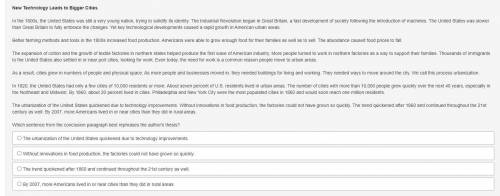
New Technology Leads to Bigger Cities
In the 1800s, the United States was still a very young nation, trying to solidify its identity. The Industrial Revolution began in Great Britain, a fast development of society following the introduction of machines. The United States was slower than Great Britain to fully embrace the changes. Yet key technological developments caused a rapid growth in American urban areas.
Better farming methods and tools in the 1800s increased food production. Americans were able to grow enough food for their families as well as to sell. The abundance caused food prices to fall.
The expansion of cotton and the growth of textile factories in northern states helped produce the first wave of American industry. More people turned to work in northern factories as a way to support their families. Thousands of immigrants to the United States also settled in or near port cities, looking for work. Even today, the need for work is a common reason people move to urban areas.
As a result, cities grew in numbers of people and physical space. As more people and businesses moved in, they needed buildings for living and working. They needed ways to move around the city. We call this process urbanization.
In 1820, the United States had only a few cities of 10,000 residents or more. About seven percent of U. S. residents lived in urban areas. The number of cities with more than 10,000 people grew quickly over the next 40 years, especially in the Northeast and Midwest. By 1860, about 20 percent lived in cities. Philadelphia and New York City were the most populated cities in 1860 and would soon reach one million residents.
The urbanization of the United States quickened due to technology improvements. Without innovations in food production, the factories could not have grown so quickly. The trend quickened after 1860 and continued throughout the 21st century as well. By 2007, more Americans lived in or near cities than they did in rural areas.
Which sentence from the conclusion paragraph best rephrases the author's thesis?
The urbanization of the United States quickened due to technology improvements.
Without innovations in food production, the factories could not have grown so quickly.
The trend quickened after 1860 and continued throughout the 21st century as well
.
By 2007, more Americans lived in or near cities than they did in rural areas.


Answers: 1


Another question on English

English, 21.06.2019 19:00
Which of the following arguments uses a non sequitur fallacy? a. if we allow students to wear caps to school, soon we'll have to let them wear gang colors. b. you should vote for sylvia for class president because everyone else on the squad is voting for her. c. regulations on motorists should be lifted because factories are a bigger source of pollution. d. the gray wolves of winter falls park should be protected because they need our support.
Answers: 1

English, 21.06.2019 22:00
Write a description about a boy with blonde hair that falls perfectly without him even trying.
Answers: 1

English, 21.06.2019 22:30
1. a poem that tells a story irony 2. taking on human characteristics narrative 3. a direct comparison between two things personification 4. words that are opposite the thoughts in a speaker's mind simile 5. implied comparison introduced with "as" and "like idiom 6. one's own manner of speaking metaphor
Answers: 2

You know the right answer?
New Technology Leads to Bigger Cities
In the 1800s, the United States was still a very young natio...
Questions

Computers and Technology, 24.04.2020 19:31





Mathematics, 24.04.2020 19:31




English, 24.04.2020 19:31










Computers and Technology, 24.04.2020 19:31



